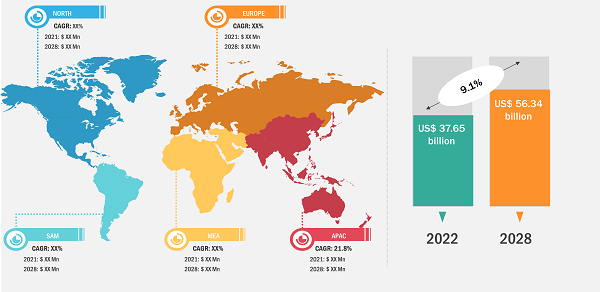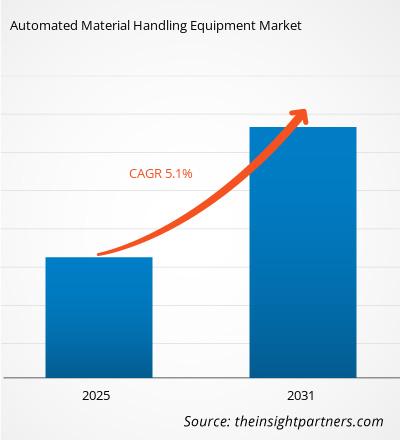自动化物料搬运设备市场规模预计将从 2022 年的 356.5 亿美元增长到到2031年将达到563.4亿美元;预计 2022 年至 2031 年复合年增长率为 9.1%。
工业机器人技术与人工智能 (AI)、大数据和其他技术的结合日益紧密。预计未来机器人将提高生产力,为人类提供先进的智能帮助。自动化物料搬运系统是使用机器人代替人工的计算机化技术。这些系统用于提升、拉动、存储、推动和检索材料和产品。自动化物料搬运系统可以在不同的应用领域(包括制造工厂和仓库)带来新的生产力。工业机器人的不断发展时代正在促进自动化物料搬运设备市场增长。
参与者正在大力投资开发与人工智能集成的工业机器人。此外,中国政府正在加大力度将人工智能融入工业机器人。一体化将减少人为干预,这将有利于劳动力不足且昂贵的国家。然而,这也可能导致劳动密集型经济体失业。
此外,机器人技术的采用率更高,大数据的增加预计,在预测期内,电子商务倾向的增加以及微型履行中心的激增将在自动化物料搬运设备市场创造利润丰厚的商机。
战略见解
自动化物料搬运设备市场的区域分析
从区域来看,欧洲是全球市场第二大自动化物料搬运设备市场份额区域。 汽车、电子及半导体、电子商务、金属及重型机械和欧洲国家的许多行业正在大量采用自动化物料搬运 (AMH) 设备。包括罗马尼亚、斯洛伐克、立陶宛、葡萄牙和爱沙尼亚在内的中欧和东欧国家在各个行业中大量采用 AMH 设备。捷克共和国和波兰是增长最快的国家,AMH 设备安装量分别增长了 40% 和 25%。德国和意大利等拥有强大汽车市场份额的国家已经注意到 AMH 设备的大量采用。
以下是一些地区汽车装配和生产工厂的统计数据:
- 该地区有 301 家汽车装配和发动机生产厂。在这些植物中,有 194 种位于欧盟境内。
- 该地区有 134 家工厂生产乘用车,52 家生产重型汽车(卡车),41 家生产轻型商用车(货车),72 家生产发动机,66 家生产巴士,18 家生产电池。
- 德国、法国、意大利、荷兰、波兰和西班牙是拥有汽车装配和生产工厂的主要国家。
因此,庞大的汽车工业的存在正在推动AMH设备在欧洲的安装。
利润丰厚的地区 -自动化物料搬运设备市场
 市场洞察——自动化物料搬运设备市场
市场洞察——自动化物料搬运设备市场
系统类型-基于洞察
根据系统类型,自动物料搬运设备市场分为单位负载和散装负载。 2022年,单位负载细分市场将占据更大的市场份额。由于单位负载 AMH 系统易于施工且实用,该系统受到大多数行业的青睐。随着工厂自动化的不断增长,对这些类型材料的需求处理系统也将增加。单位负载 AMH 通常在半成品操作中引入,以支持生产过程中的准时交货和缓冲存储。汽车、金属等制造业重型机械、半导体和电子产品是单位负载 AMH 系统的几个主要消费者。单元负载在高密度托盘存储、特殊负载、货到人技术、冷库和物流方面的应用不断增长。冷冻储存、缓冲和储存预计未来几年,分段式将能够采用单元负载来处理大型和重型负载。上述有关使用单位负载的方面将为全球自动化物料搬运设备市场做出贡献。
自动化物料搬运设备市场参与者主要专注于开发先进、高效的产品。
- 2023 年 1 月,Trew, LLC(自动化物料搬运解决方案提供商)宣布:它正在扩大其在俄亥俄州西南部(美国)的足迹。该公司的目标是建立一个技术中心,以加速物料搬运解决方案的创新,同时创造至少 75 个新的工程岗位。该公司将获得来自 JobsOhio 的高达 400 万美元的研发补助金。这笔赠款将使 Trew 能够开发仓库执行软件和自动化技术,并创建演示、测试和培训设施。
- 2022 年 12 月,Ensign Equipment Inc.,一家用于处理干散装固体的物料搬运设备和集成系统供应商,完成了组装厂的扩建。此次扩建将使 Ensign Equipment Inc 的装配空间增加一倍,满足对自动化物料搬运解决方案不断增长的需求。
自动化物料搬运设备市场规模分为五个主要区域——北美、欧洲、亚太地区 (APAC)、中东和中东地区。非洲、南美洲。 2022 年,亚太地区以可观的收入份额引领自动化物料搬运设备市场,其次是欧洲。此外,预计 2022 年至 2031 年,亚太地区的自动化物料搬运设备市场复合年增长率最高。
大福有限公司;海斯特-耶鲁物料搬运公司;永恒力股份公司;凯傲集团股份公司;丰田自动织机公司;韩华公司;约翰·比恩技术公司;库卡股份公司;博曼集团有限公司公司;和法孚集团是该行业自动化物料搬运设备市场的主要参与者。市场报告提供了详细的市场洞察,有助于主要参与者制定未来几年的增长战略。
- 历史分析(2 年)、基准年、预测(7 年)及复合年增长率
- PEST 和 SWOT 分析
- 市场规模价值/数量 - 全球、区域、国家
- 行业和竞争格局
- Excel 数据集


- Blood Collection Devices Market
- Sleep Apnea Diagnostics Market
- Medical Devices Market
- Microplate Reader Market
- Cut Flowers Market
- UV Curing System Market
- Europe Tortilla Market
- Advanced Planning and Scheduling Software Market
- Small Molecule Drug Discovery Market
- Environmental Consulting Service Market

Report Coverage
Revenue forecast, Company Analysis, Industry landscape, Growth factors, and Trends

Segment Covered
This text is related
to segments covered.

Regional Scope
North America, Europe, Asia Pacific, Middle East & Africa, South & Central America

Country Scope
This text is related
to country scope.
常见问题
Some of the customization options available based on request are additional 3–5 company profiles and country-specific analysis of 3–5 countries of your choice. Customizations are to be requested/discussed before making final order confirmation, as our team would review the same and check the feasibility.
The Automated Material Handling Equipment Market is expected to register a CAGR of 5.1% from 2023-2031.
The major factors impacting the Automated Material Handling Equipment Market are: Increasing Demand for Automation in Warehousing, Rising Adoption in E-commerce and Retail, and Technological Advancements in Robotics and AI
Key future trends in this market are - Growth in e-commerce logistics, Adoption of robotics in warehouses, Demand for operational efficiency
The report can be delivered in PDF/PPT format; we can also share excel dataset based on the request.
Key companies in this market are: Fives, Jungheinrich AG, Kion Group AG, kuka AG, Daifuku Co Ltd, Hyster Yale Materials Handling Inc, BEUMER Group GmbH Co KG, Hanwha Corporation, John Bean Technologies Corporation
Trends and growth analysis reports related to Electronics and Semiconductor : READ MORE..
The List of Companies
1. Fives
2. Jungheinrich AG
3. Kion Group AG
4. kuka AG
5. Daifuku Co., Ltd.
6. Hyster-Yale Materials Handling, Inc.
7. BEUMER Group GmbH & Co. KG
8. Hanwha Corporation
9. John Bean Technologies Corporation
10. Toyota Industries Corporation
The Insight Partners performs research in 4 major stages: Data Collection & Secondary Research, Primary Research, Data Analysis and Data Triangulation & Final Review.
- Data Collection and Secondary Research:
As a market research and consulting firm operating from a decade, we have published and advised several client across the globe. First step for any study will start with an assessment of currently available data and insights from existing reports. Further, historical and current market information is collected from Investor Presentations, Annual Reports, SEC Filings, etc., and other information related to company’s performance and market positioning are gathered from Paid Databases (Factiva, Hoovers, and Reuters) and various other publications available in public domain.
Several associations trade associates, technical forums, institutes, societies and organization are accessed to gain technical as well as market related insights through their publications such as research papers, blogs and press releases related to the studies are referred to get cues about the market. Further, white papers, journals, magazines, and other news articles published in last 3 years are scrutinized and analyzed to understand the current market trends.
- Primary Research:
The primarily interview analysis comprise of data obtained from industry participants interview and answers to survey questions gathered by in-house primary team.
For primary research, interviews are conducted with industry experts/CEOs/Marketing Managers/VPs/Subject Matter Experts from both demand and supply side to get a 360-degree view of the market. The primary team conducts several interviews based on the complexity of the markets to understand the various market trends and dynamics which makes research more credible and precise.
A typical research interview fulfils the following functions:
- Provides first-hand information on the market size, market trends, growth trends, competitive landscape, and outlook
- Validates and strengthens in-house secondary research findings
- Develops the analysis team’s expertise and market understanding
Primary research involves email interactions and telephone interviews for each market, category, segment, and sub-segment across geographies. The participants who typically take part in such a process include, but are not limited to:
- Industry participants: VPs, business development managers, market intelligence managers and national sales managers
- Outside experts: Valuation experts, research analysts and key opinion leaders specializing in the electronics and semiconductor industry.
Below is the breakup of our primary respondents by company, designation, and region:

Once we receive the confirmation from primary research sources or primary respondents, we finalize the base year market estimation and forecast the data as per the macroeconomic and microeconomic factors assessed during data collection.
- Data Analysis:
Once data is validated through both secondary as well as primary respondents, we finalize the market estimations by hypothesis formulation and factor analysis at regional and country level.
- Macro-Economic Factor Analysis:
We analyse macroeconomic indicators such the gross domestic product (GDP), increase in the demand for goods and services across industries, technological advancement, regional economic growth, governmental policies, the influence of COVID-19, PEST analysis, and other aspects. This analysis aids in setting benchmarks for various nations/regions and approximating market splits. Additionally, the general trend of the aforementioned components aid in determining the market's development possibilities.
- Country Level Data:
Various factors that are especially aligned to the country are taken into account to determine the market size for a certain area and country, including the presence of vendors, such as headquarters and offices, the country's GDP, demand patterns, and industry growth. To comprehend the market dynamics for the nation, a number of growth variables, inhibitors, application areas, and current market trends are researched. The aforementioned elements aid in determining the country's overall market's growth potential.
- Company Profile:
The “Table of Contents” is formulated by listing and analyzing more than 25 - 30 companies operating in the market ecosystem across geographies. However, we profile only 10 companies as a standard practice in our syndicate reports. These 10 companies comprise leading, emerging, and regional players. Nonetheless, our analysis is not restricted to the 10 listed companies, we also analyze other companies present in the market to develop a holistic view and understand the prevailing trends. The “Company Profiles” section in the report covers key facts, business description, products & services, financial information, SWOT analysis, and key developments. The financial information presented is extracted from the annual reports and official documents of the publicly listed companies. Upon collecting the information for the sections of respective companies, we verify them via various primary sources and then compile the data in respective company profiles. The company level information helps us in deriving the base number as well as in forecasting the market size.
- Developing Base Number:
Aggregation of sales statistics (2020-2022) and macro-economic factor, and other secondary and primary research insights are utilized to arrive at base number and related market shares for 2022. The data gaps are identified in this step and relevant market data is analyzed, collected from paid primary interviews or databases. On finalizing the base year market size, forecasts are developed on the basis of macro-economic, industry and market growth factors and company level analysis.
- Data Triangulation and Final Review:
The market findings and base year market size calculations are validated from supply as well as demand side. Demand side validations are based on macro-economic factor analysis and benchmarks for respective regions and countries. In case of supply side validations, revenues of major companies are estimated (in case not available) based on industry benchmark, approximate number of employees, product portfolio, and primary interviews revenues are gathered. Further revenue from target product/service segment is assessed to avoid overshooting of market statistics. In case of heavy deviations between supply and demand side values, all thes steps are repeated to achieve synchronization.
We follow an iterative model, wherein we share our research findings with Subject Matter Experts (SME’s) and Key Opinion Leaders (KOLs) until consensus view of the market is not formulated – this model negates any drastic deviation in the opinions of experts. Only validated and universally acceptable research findings are quoted in our reports.
We have important check points that we use to validate our research findings – which we call – data triangulation, where we validate the information, we generate from secondary sources with primary interviews and then we re-validate with our internal data bases and Subject matter experts. This comprehensive model enables us to deliver high quality, reliable data in shortest possible time.

 获取此报告的免费样本
获取此报告的免费样本